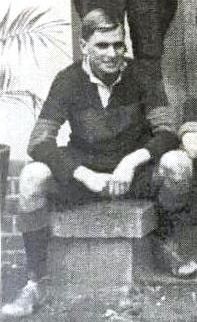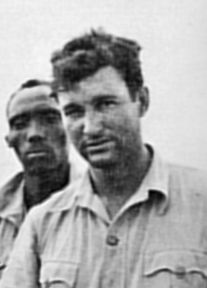View entry
Name: SELBY, John Henry 'Harry'


Nee: son of Arthur Gilbert and Myrtle Evelyn Selby
Birth Date: 22 July 1925 Frankfort, Orange Free State, S. Africa
Death Date: 20 Jan 2018 Maun, Botswana
Profession: Professional hunter
Area: Nanyuki
Married: 1953 Marie Elizabeth 'Miki' Clulow
Children: Mark (d. 2017); Gail
Book Reference: Ruark, Kingsley-Heath, Barnes
General Information:
Ruark - Not yet 27 in 1951 but an able pro since he was 20. Born and raised in EA, on a cattle farm in Nanyuki. Killed his first elephant before he was 15. Looks like a public schoolboy and speaks an impeccable British English in such a gentle voice that even an occasional "damn" sounds very wicked.
Kingsley-Heath - J.H. Selby 'Harry' - Immortalised in 'Something of Value' and 'The Horn of the Hunter' by Robert Ruark. Originally with Ker & Downey Safaris, he left and started his own company with Andrew Holmberg - Selby & Holmberg. Later rejoined Ker & Downey which became Ker, Downey & Selby Safaris and was subsequently bought by the owners of Safari South (Pty) Ltd. In Botswana, where Harry was the managing director of KDS Safaris. Probably the longest serving professional hunter working today, he has been hunting continuously for 50 years. His son, Mark, is also a professional hunter in Botswana, where the Selby family resides in Maun.
Played rugby for Ruiru 1933
Sitrep Dec 2018 LIII Robert D. McFadden on Harry Selby: Harry Selby, one of the last of Africa's renowned white hunters, who took rich and famous safari clients into the interiors of Kenya, Tanganyika and Botswana for a half-century to shoot game, photograph exotic wildlife and search for elusive adventure in the bush, died on Saturday 20th January 2018, at his home in Maun, Botswana. His death was confirmed by his friend Joe Coogan, an American writer and hunter who had worked on safaris with Mr. Selby. Mr. Coogan said he was notified in a message from Botswana by Mr. Selby's daughter, Gail. No cause was given. Mr. Selby grew up on a ranch astride the Equator in Kenya, watching enormous herds of zebra and impala, sniffing for lion and Cape buffalo, listening to an elephant scream and hyenas giggling at sundown. In the burning heat, he learned to track an animal over rocky ground, and to avoid the rhino laid up in the dusty shade of an acacia tree. He shot his first antelope at eight, his first elephant at fourteen. Mr. Selby was a post-war protegé of the East Africa hunter Philip Hope Percival, who took Theodore Roosevelt and Ernest Hemingway on safaris, and he became a professional hunter himself in the late 1940s. He took the American author, Robert Ruark on safari in Tanganyika (now Tanzania), and with the 1953 publication of Ruark's bestselling book "Horn of the Hunter," Mr. Selby became one of Africa's most famous hunting guides. Drawn to the romance of treks to kill lions, elephants and rhinos and to photograph native tribes and storybook landscapes, clients flocked from around the world to Selby safaris, which were booked for years with clients like Prince Bernhard of the Netherlands, the Maharajah of Jaipur, Prince Stanislas Radziwill of Poland and Western tycoons, industrialists and chief executives seeking thrills and self-fulfilment. Those were anticipated wonders not always to be found in the real Africa. In the Hollywood-inspired popular images of the 1950S, the great white hunter was a fearless Clark Gable or Stewart Granger, tall and deeply tanned, who brought down a charging rhino with a single shot while his arrogant client cowered behind him, and who later romanced the client's neglected wife after saving her from a snarling lion. The reality was Mr. Selby; short and stocky, mild and self-effacing, a man who seemed to listen with his eyes. He had curly hair, a boyishly shy smile, and a wife and two children. He catered to men used to giving orders, not taking them, but did it with tact, avoiding upbraiding a client needlessly and almost never finding it necessary to save anyone. Neither he nor any client was ever seriously injured on a safari, though there were some close calls. 34 It was not all shooting and campfire tales. A Selby safari required an army of bearers, cooks, skinners, porters, drivers and others; game licenses and financial transactions; transportation arrangements, from trucks and horses to planes and boats; and a complex coordination of supplies and equipment; weapons and ammunition, food, water, tents, cots, radios, medicines, maps, clothing and a thousand other necessities. Without cell-phones or evacuation helicopters, Mr. Selby had to be the doctor, mechanic, chauffeur, gin-rummy-and-drinking partner and universal guide, knowledgeable about mountain ranges, grassy plains, rivers, jungles, hunting laws, migratory patterns, and the Bushmen, Masai, Samburu, Dinka and Zulu tribes. He spoke three dialects of Swahili. And he improvised; if there was no firewood, he burned wildebeest dung. He was no Gregory Peck, but had an easygoing personality that made for good company in the bush. He coped with emergencies, pulling a client clear of a stampede or a vehicle from a bog, treating snakebites or tracking a wounded lion in a thicket - his most dangerous game. He was lefthanded, but his favourite gun was a right-handed ·416 Rigby, which can knock down an onrushing bull elephant or Cape buffalo in a thundering instant. Safaris changed dramatically in his time. In Kenya and Tanganyika in the late 1940s and '50s, he took parties hundreds of miles into trackless bush country by truck, pitched camps with comfortable though primitive amenities, drank gin by kerosene lamp, and pursued game by his own instincts. Safaris lasted two or three months. The showers were often cold, but the food was good and the game plentiful. In his later years in Botswana, safaris went out for just a few weeks and focused as much, if not more, on photography as on hunting, although Mr. Selby preferred hunters. Photography buffs stayed in hotel-like lodges and went on day trips to scenic sites. More adventurous hunters and photographers were flown to rendezvous points and driven in Land Rovers to fixed camps elaborately equipped with electric power, refrigerators, flush toilets, hot showers, kitchens and dining facilities with silverware and table linen. "Africa itself has changed out of all recognition, both physically and politically, and the old-time self-contained safari would have no place to go in today's Africa," Mr. Selby wrote for Sports Afield in 2010, when satellite phones, computers and helicopters made life easy for the busy executive on safari. "There are hunters today," he added, "who would prefer to have experienced the sense of freedom of an old-time safari, as I’m sure there were those who went on safari many years ago who would have preferred something along the lines of what is offered today. The two experiences are as different as night is from day; the only feature common to both is the name ... that magical word, ‘safari.’ John Henry Selby - Harry was his universal nickname - was born in Frankfort, South Africa, on 25th July 1925, the youngest of six children of Arthur and Myrtle Evelyn Randall Selby. When he was three his family moved to a 40,000 acre cattle farm near Mt Kenya. Surrounded by a game-rich countryside, the boy learned to hunt from an old Kikuyu tribesman. "He taught me to use my eyes and ears as well as my nose, and to be patient in order to remain motionless for long periods of time waiting for an animal to come within range," Mr. Selby told The American Rifleman. 35 Mr. Selby attended local schools, travelling by ox cart, and later the Prince of Wales, a boarding school in Nairobi. After World War II, he worked for Mr. Percival, who recognized his potential as a hunter-guide, and in 1949 he joined East Africa's foremost safari outfitter, Ker & Downey, based in Nairobi. In 1956, after Mr. Ruark's book had made him famous, he formed his own safari company, Selby & Holmberg. In 1953, he married Maria Elizabeth Clulow, known as Miki. They had two children, Mark and Gail. Mark died in 2017. Mr. Selby is survived by his wife, daughter and a number of grandchildren. In 1962, as Kenyan independence loomed and political upheavals dimmed prospects for safaris in East Africa, he accepted a partnership in his old company, which became Ker, Downey and Selby, and in 1963 moved as it’s trailblazer to Bechuanaland, a British protectorate that became independent Botswana in 1966. It was a hunter's and a photographer's paradise. "What we found exceeded our wildest expectations; a land which the passage of time had passed by, where nature had remained unchanged in the 20th century," Mr. Selby said in a 2013 interview for this obituary. "The vast savannas were teeming with huge herds of elephant, buffalo, kudu, zebra, wildebeest and sable. Lions were everywhere, showing little fear of man." For 30 years, Mr. Selby ran company operations in Botswana, and guided hunters and photographers into leased concessions covering thousands of square miles in the Okavango Delta in the north and the vast Kalahari Desert in the south, home of the click-talking Bushmen. He cut tracks and built airfields in the wilderness. In 1970, he established Botswana's first lodge and camps for photographic safaris. He hired guides and a large support staff for what became a dominant safari business in Southern Africa. After Ker, Downey and Selby was bought by Safari South in 1978, he remained a director, and even after resigning in 1993 he continued to lead safaris privately until retiring in 2000. In 2007, President Festus Mogae of Botswana [Ed: 1999-2004], awarded Mr. Selby the Presidential Certificate of Honour in recognition of his contributions to hunting and photographic tourism.
